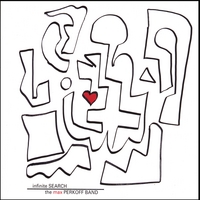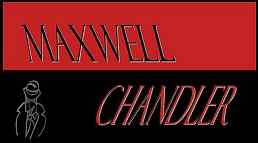
| Maxwell's page twelve. The New Wave. | ||||||||||
Infinite Search -The Max Perkoff Band

Randy Vincent-guitar
Max Perkoff-trombone/piano
Cami Thompson-vocals (track 4)
Sam Bevan-bass
Paul van Wageningen-drums
San Francisco and New York are probably two of the best cities to see jazz in, stateside. Both cities get many of the remaining living legends, plus artists who rarely tour (America) and things of a more eclectic nature.
Both cities wear their cosmopolitan label with pride and, jazz-wise have the pedigree to back it up. New York had the 52nd street scene, Birdland, The Village Vanguard. San Francisco had Bop City, The Blackhawk and The Keystone Corner.
While I take full advantage of the great jazz available with its line up of legends, lately I have been also looking towards the future. A little game a bunch of us play is “who will we be seeing in concert ten, twenty, thirty years down the line, when all the remaining legends are gone? “
With this in mind I have been checking out some of the younger players on the scene. I first discovered Max Perkoff as a guest star during one of the Monk’s Music Trio performances. The trio features his piano playing father Si, but since my initial discovery I have seen Max play in other ensembles which proved to be different but equally enjoyable.
What I have come to learn about Max is that a key component of his art is a diversity of palette. This is true of his various live concert situations and now of his albums as well.
His new one is the sixth as a leader and the first to feature a program of all original compositions. The CD is full of stylistic shifts, but manages to encompass various influences seamlessly. The exploration of different genres is not done out of commercial considerations, but from the band’s inherent desire and ability to explore different fabrics of the vast tapestry known as jazz.
The organic mélange of moods prevents the CD from being a soundtrack regulated to specific times, places or conditions. There is never a patchwork feel, but more one of shifting ideas and moods as one would encounter in a good conversation.
Of late, trombone is used as part of large ensembles and given brief moments to speak up and shine. Smaller combos which eschew other brass on the front line aside from a ‘bone often tonally give the sense of something missing. The band is Max’s regular working/road band and their familiarity with one another prevents any sonic holes or dead spaces from appearing.
While all the compositions are Max’s each band member contributed ideas for their parts and this too adds to a fuller sonic cohesion. Not once do you get the feeling you are listening to a lead instrument’s album where the others are allowed token moments to speak out.
One of the pleasures of this album which is immediately apparent are the Sonics involved. It sounds like a band playing, together, they avoided the frigidity which can occur on modern jazz recordings when things are “too clean”. There is an ambient reverb which harkens back to jazz’s pre-digital age and will allow the album to age well.
The other aspects of the album’s sonics are tied in with the musicians playing and are equally as pleasing.
While his personal style is ever present, the cadence of Max’s ‘bone changes from piece to piece over the course of the album. Some of the best moments, conjuring up a drunken bumble-bee, fully articulate as he joyfully sings his song. Over all, Max’s tone and playing are built off of some of those who came before (J.J Johnson) but incorporating his own thing with an influx of inspirations not available to his artistic forefathers. I find that he has progressive leanings, but never so much as to alienate the more casual jazz listener.
Some pieces find Max at the piano bench where he displays a limpid, percussive style which live, shows a bright punch. When Max is back to his ‘bone though, its sonic spot on the bandstand is replaced by guitar. There is a tastefulness in everything Randy plays, whether it is the throaty tube inflexed solo found on Dr. King or the almost organ like chime that subtly announces his presence on New Life.
It is also almost becoming a forgotten pleasure for a guitar to just sound like a guitar without it being pumped through all the au-current studio gadgets available. There is a liter or two, at least, of soul jazz to be found in Randy’s blood, devoid of any potential clichés of the genre.
The song Just Enough is the blues by way of Bossa Nova. There is a bass solo which is a thing of beauty, a fat rich tone which manages to not waste any time. Sam can play, but does not have to overly prove it with every solo statement and this furthers the strength of what he shows us. Witness the guitar coming in, a perfect Gemini twin. Two artists speaking in one voice. The effect of the drums, the time passes without notice.
Sunset in Sienna is a short dramatic track, perfectly placed, it serves as a sort of prelude to Memories of Lady Day. The tone of Max’s ‘bone, the mood of the piece, a beautiful woman, melancholy, who laughs despite herself.
Aside from pieces dedicated/inspired by other artists (J.J Johnson, Barry Harris, Billy Holiday) there is one to Dr. King and one for Rosa Parks. These pieces are completely devoid of dogma and are as enjoyable to a listener unaware of their inspiration/dedication.
The start of Death of Democracy finds the drums taking a lead role without putting ones ears at risk and without any monotony at all. Indeed, throughout the album he provides a subtle spark to each piece. Max’s description of the piece reminded me of the print/quote by Goya “The sleep of reason produces monsters”. The piece has an almost free-bop feel to it, it manages to switch emotional gears in an effortless sonic stream.
In a live situation, I imagine this song being a great launching off point. A traverse across emotional landscapes of then, that moment. One of the great, unending aspects of jazz, an amalgam of in the moment, being birthed within the established structure of a piece.
The song J.J’s Backroom Part 1 is a successful exercise in solo virtuosity. A reminder that a great musician can create compelling music, singing in only one lone voice.
The album clocks in at just under an hour. It has many other memorable moments including guest vocals on track four by Cami Thompson whom Max has worked with over the years. The liner notes are by Max and offer brief explanation of each piece. The sound is pristine and the packaging features cover art by Sara Goren (Max’s mother) which is reminiscent of some of the duo-chrome work of Franz Kline.
Information on where to find the album can be had at Max’s site
I will lament when all the original jazz titans are gone, but will still find joy in all those who I am discovering now.
Maxwell will return with more adventures in sound
![]()
| Click Here |
Page one of Max's Jazz reviews
